#$100/month compared to 400
Explore tagged Tumblr posts
Text
Damn
Health insurance gets a lot cheaper when theyre not taking my moms income into account
#$100/month compared to 400#i couldve also gotten several free ones but the copays were a lot higher also if i actually had to USE my insurance for more than regular#doctor visits the deductible and out of pocket expenses were way higher#and i dont go to the doctor as much as i probably should but i might start#this one has a $3000 deductible and only 700 out of pocket as opposed to 7000 deductible and 9000 out of pocket#which is more reasonable#i did not check if gender affirming care is covered cuz my mom was helping me and i got stuck debating if i wanted to get into that rn#the anxiety won out in the end#if my dad hadnt been sitting on the couch gaming i mightve been able to push through it#id rather just tell my mom and then SHE can tell other people#like with my autism#i mean. she tries not to do that cuz she hared when her mom shared personal information about her with other people#but mom. pls. i hate talking to people. i will avoid conversations as much as possible. even if its things i want people to know about me#please just tell them for me so i dont have to#at least when it comes to family#i can tell my friends shit#most of the time#but it helps that i have grandmas on both sides that are extroverts that tend to overshare#mom just has to tell them and itll get out there#i use my oversharing grandmas to my advantage#i just have to be strategic in what i tell them#or in most cases what i want my mom to tell them
0 notes
Text
student loans not forgiven chewing through my cage bars smashing things on the ground blood everywhere blood everywhere blood everywhere
#oisín.txt#oisín.n#back when we got bonuses at work i was using them to like. actually have savings#they're supposed to come back in october but i'm gonna have to start using them for loans#i KNOW the save plan or whatever but the save plan is deranged and thinks i can afford $400/month#so now i'm on the $50/month and gonna try to pay a couple hundred even still bc i want them GONE#i was paying $300 a month at my old place before it got paused but i genuinely don't know how bc i couldn't afford anything when i was there#even during the pause. so that seems weird#gotta try to channel the version of me that was making that happen tho. maybe i won't turn down a raise. i was thinking i would bc they're#doing something evil and fucked up w our raises this quarter where they're deliberately paying less than industry average to anyone they#promote and once you're under 100% compare rate you're stuck there like you can't negotiate back out but. maybe i'll still take it and try#idk but i'm going to scream
1 note
·
View note
Text
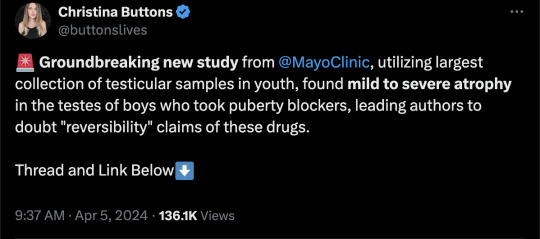
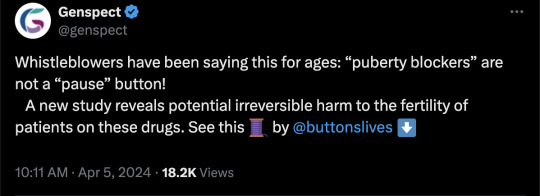
By: Christina Buttons
Published: Apr 4, 2024

[ Figure 2: Representative images of Hematoxylin and Eosin-stained sections of testicular tissue biopsied from the testis from GD patients (A) with and (B) without PB exposure. ]
In a groundbreaking study from the Mayo Clinic, a globally recognized leader in medical research and patient care, researchers examined the effects of puberty blockers on testicular development in gender dysphoric male children. Their investigation revealed evidence of mild to severe atrophy in the sex glands of these children, leading the authors to express doubt in the claims of “reversibility” often made about puberty blockers.
The authors assert, “We provide unprecedented histological evidence revealing detrimental pediatric testicular sex gland responses to [puberty blockers].”
This preprint study, not yet peer-reviewed, presents evidence that puberty blockers induce significant cellular changes, impacting testicular development and sperm production in ways that are not fully reversible, with potentially permanent effects on testicular function and fertility. It challenges the longstanding view of puberty blockers as a reversible "pause button" on puberty.
As noted by the researchers of this study, no long-term studies exist for the use of puberty blockers in the context of stopping puberty for gender dysphoric children, and many potential health consequences remain unknown. In particular, the long-term impact on reproductive health is uncertain, making this study critical for filling this knowledge gap.
To address these unknowns, the Mayo Clinic has established the largest collection of testicular samples for patients aged 0-17 years, including those with gender dysphoria who have and have not yet received puberty blocker treatment, creating a database of over 130,000 individual cells for analysis.
Using a novel approach, the research team meticulously analyzed testicular tissue samples from youths undergoing puberty blocker treatment, with those not on puberty blocker treatment serving as controls. This comparison provides important insights into the potential cellular and molecular changes induced by these drugs.
Key Findings
The study utilized the Mayo Clinic's Pediatric Testicular Biobank for Fertility Preservation, which has been recruiting patients primarily from pediatric urology departments since 2015. Researchers analyzed testicular specimens from 87 young individuals (ages 0-17) undergoing fertility preservation surgery for various health reasons. Among these, 16 were gender dysphoric boys between the ages of 10 and 16, all of whom began identifying as transgender girls between the ages of 2 and 15. At the time of surgery, 9 patients (56%) were already on puberty blockers, with exposure ranging from 3 to 52 months. The authors noted that 100% of the 16 children would eventually go on to take them, highlighting “the widespread nature of PB intervention in this demographic.”
Among nine patients treated with puberty blockers, two exhibited unusual features in their testicles upon physical examination. One patient had abnormalities in both testicles, including incomplete development of the tunica albuginea, which is a protective covering around the testicles. The other patient had a right testicle that was difficult to detect.
In one part of the tissue-level analysis, over 400 testicular biopsy samples were analyzed and stained to examine the differences between those treated with puberty blockers and those who were not. Comparisons showed that testicular development in those treated with puberty blockers was abnormal compared to non-treated individuals. There was variability in how individuals responded to puberty blockers, leading to different outcomes in testicular development, including the degeneration of testicular tissues.
The study authors presented a case of a 12-year-old patient who underwent treatment with puberty blockers for 14 months. In this individual, 59% of the sex glands showed complete atrophy, along with the presence of microlithiasis—a condition where small clusters of calcium form in the testicles. This insight suggests that puberty blockers could lead to lasting structural changes. Additionally, research has shown a link between testicular microlithiasis and testicular cancer.

[ D) Representative images of normal (top) and fully atrophied sex gland (bottom). ]
This study also utilized single-cell analysis to investigate the effects of puberty blockers and aging on testicular cell composition. It took a very detailed look at individual cells from the testicles of a 14-year-old who had been on puberty blockers for over 4 years. The study analyzed a total of 130,100 cells, including 11,199 cells from the juvenile puberty blocker-treated patient.
The study observed that over 90% of the cells responsible for sperm production in this patient were stunted at an early developmental stage, unable to progress further. Additionally, it found "pathologically" higher and lower levels of two types of support cells (Sertoli cells) necessary for healthy sperm development. These findings suggest that puberty blockers can disrupt the normal maturation process of cells critical for sperm production.
In another part of the analysis, the authors found distinct cell-specific changes, including altered expression patterns of puberty-associated genes in endothelial cells, due to puberty blocker treatment. The authors believe that these drugs might induce juvenile testicular atrophy in part by disrupting the normal function of testicular endothelial cells.
Another aspect of the study focused on examining the effects of puberty blockers on the genetic activity of early-stage sperm cells, revealing significant changes that could potentially influence their development and fertility. By analyzing the activity of specific genes within these cells, the researchers found that puberty blockers may have caused alterations in gene expression, affecting processes crucial for the normal growth and function of these cells. This analysis suggests that the use of puberty blockers in gender dysphoric youth could have lasting implications for their reproductive health, particularly by impacting the ability of these early-stage sperm cells to mature properly.
Study Impact
Puberty blockers are increasingly used as a treatment for gender dysphoric youth to halt the development of secondary sex characteristics, such as breast development and widening of hips in females, or the growth of facial hair and deepening of the voice in males. Thousands of children in the United States are placed on this medical pathway as part of the gender-affirming model of care, under the presumption that these drugs are safe and fully reversible.
However, many aspects of the long-term consequences of puberty blockers, which have been administered to children off-label in an experimental manner, remain unknown. This study contributes valuable insights into the potential irreversible harm these treatments can cause to bodily and reproductive functions.
Arguably, the most critical finding is the evidence of mild to severe sex gland atrophy in children treated with puberty blockers. This atrophy signifies potential damage or impairment to the structures essential for sperm production, raising serious concerns about the long-term fertility impacts of these drugs for these individuals.
Given the Mayo Clinic's esteemed reputation in the medical and research communities, should the study pass peer review without any issues, its findings will carry significant weight.
Broader Implications
Puberty blockers belong to a group of synthetic gonadotropin-releasing hormone (GnRH) analogues. These drugs act on the pituitary gland to hinder the release of chemical signals that typically trigger the production of estrogen and testosterone. Historically GnRH analogues were used to treat conditions such as prostate cancer, fibroids, and endometriosis and, in some cases, as a measure to chemically castrate sex offenders.
In children, puberty blockers prevent the natural changes of puberty driven by sex hormones and have been used to treat central precocious puberty, a condition where a child begins to sexually mature much earlier than usual. In gender dysphoria, puberty blockers are administered experimentally, lacking long-term testing.
Notably, the U.S. Food and Drug Administration (FDA) has not approved puberty blockers and sex hormones for use in pediatric gender care. No clinical trials have substantiated the safety of these drugs for such non-approved applications and manufacturers of puberty blockers have repeatedly declined to conduct safety trials for their use on this cohort.
While puberty-blocking drugs are often promoted as “safe,” "reversible" and a "pause button" on puberty, these characterizations seem to stem from their approved use for treating central precocious puberty in younger children, not their burgeoning off-label use for managing gender dysphoria in adolescents.
Past studies have indicated possible negative effects on bone density and brain health. There is also a concern that these drugs might solidify gender dysphoria in adolescents, potentially leading them down a lifelong road of biomedical interventions. Following reports in 2016 of suicidal ideation in children administered puberty blockers, the FDA instructed drug manufacturers to include a warning about potential psychiatric issues on the drugs' labels.
Puberty blockers are increasingly administered to adolescents at Tanner Stage 2, the first signs of puberty. Research shows administering puberty blockers at this stage, followed by cross-sex hormones, may result in infertility, sterility, and sexual dysfunction. Furthermore, they inhibit the development of mature male genitalia, making it difficult to create a pseudovagina in the event of a later vaginoplasty due to a lack of sufficient tissue.
The National Health Service England recently announced it would no longer prescribe puberty blockers to youth outside of research settings and closed down its only national clinical service for pediatric gender medicine, following a review that deemed the service "not safe.”
Several European countries, including Sweden, Finland, the UK, Denmark, and Norway have updated their guidelines for youth transition to align with systematic evidence reviews, the gold standard in evidence-based medicine. These reviews concluded that the risks associated with youth transition outweigh any purported benefits. Consequently, these countries have implemented restrictions on medical interventions, prioritizing psychotherapy as a first-line response for minors experiencing gender-related distress.
==
They're sterilizing boys and giving them cancer. When "god" does it, we call him evil. When humans do it, we call it "gender affirming care."
#Christina Buttons#puberty blockers#atrophy#medical scandal#medical malpractice#medical corruption#sterilization#fertility#irreversible#gender affirming care#gender affirming healthcare#gender affirmation#queer theory#gender ideology#gender identity ideology#intersectional feminism#religion is a mental illness
238 notes
·
View notes
Text
Jumping on the bandwagon woo-hoo
no spam reblog or spam comment ;P
For every 100 reblogs I'll drink another bottle of water
Update: Ive drank almost 2 whole water bottles in the last 3 days which isn't much proportionally but for one, I'd probably not even drink one if it wasn't for the internet critters in my phone telling me to and also, yk, thats alot of water compared to my last few weeks getting all my fluids from food
10 reblogs: Go to bed before midnight tonight
50 reblogs: I'll make my bed in the mornings for a week
Update: I found out that my bed being made kinda stresses me out for some reason, it's just so neat I get scared, and so instead I am putting away 3 pieces of clothing that have been clean for months and i just haven't touched every morning :D
75 reblogs: I'll work on getting accommodations for my autism at school
Update: I don't have the required "proof of diagnosis" and I'd have to wait 2 years or so to get it and I won't be in school anymore at that point, so I'm working with my counselors to see what they can do aside from official autism accommodations
125 reblogs: I'll work in upping my failing grade in math
Update: Math test retake on the 12tg, wish me luck!
150 reblogs: I'll work on my dopamine addiction and get help
Update: Hooooooly shit addictions are hard. I'm going to start a timer for time between uses of YouTube shorts or Instagram reels in an effort to reduce my need for instant gratification and try to replace every time I pick my phone up with drawing or reading or talking to people around me.
200 reblogs: I'll post my art that I've been self conscious about posting
Update: I am really happy for this, it's finally an excuse for me to make myself post my art :D it's probably gonna be 1-2 drawings per post with a little background with each :3
300k reblogs: I'll start cleaning up my room
400k reblogs: I'll clean out my bag (God pls don't get to 400 yall T T)
500: I'll get sharp objects out of my room
1k reblogs: I'll be really happy :0
Edit; Added more goals
2k reblogs: I'll start streaming on twitch again!!!
3k reblogs: I'll empty out my drafts
5k: I come out as trans to my parents (I don't know if they're transphobic so to speak, but they are of the mindset that "do whatever you want once you're out of our house but until then you are our kid" but I wanna be like um no actually-)
5.5k: I come out as trans to my non-transphobic grandma
6k: I come out as trans to my transphobic grandma
Edit 2; Yo same picture of the earth reblogged me?!? the picverse found this?!?! that's insane xd
Edit 4; I added some coming out goals because I'm not gonna do it if I don't have the pressure from hundreds of little things in my phone cheering me on xd
Pinging moots so there's at least a small chance of any of these happening xd
@calimewzz @annotated-catastrophe @glitched-out-dusk @life-is-okay-rn
#now I can blame my personal failures on a lack of internet fame#instead of my own inability to function properly#>:D
307 notes
·
View notes
Text

i’m gonna start a revolution from my bed, ‘cause you said the brains i had went to my head - don’t look back in anger, oasis
[Start ID/ A self portrait drawing of the artist laying under a blanket with a gang of pillows behind him. His face is partially covered, and he holds a stuffed animal of Lambchop as he sleeps. Above the sleeping figure, texts reads “I’m gonna start a revolution from my bed” with the artist’s watermark below it. /End ID]
it’s disability pride month. as i deal with a flare up and general increase in fatigue, i find this line resonating more than it does when i’m at 100% (which at my baseline, is still starkly diminished compared to someone with an average immune system)
i am grateful to live in a digital age where i can have a platform and organize, contribute to mutual aid, and find community support from online. i appreciate it as someone with a severely compromised immune system, who regularly attends meetings online that connect me to friends, queer community events, and recovery communities. i’m grateful to work from home, connect to therapists from home, and fundraise from home!
we have been able to raise nearly $400 for esims for gaza, and i have done that from my bedroom. i pack all my orders and complete my commissions from my bedroom. i am grateful for the opportunity to do these things especially when i struggle to stay awake or i feel too weak to leave my bed.
#queer artist#disability pride month#disabled#autoimmune disease#chronic illness#chronic fatigue#chronically ill#self portrait#rare disease
22 notes
·
View notes
Text
If you, or someone you love, has ever received a big stack of medical bills just because you, for example, tripped in a parking lot, this post is for you.
Even if you have excellent insurance, you might want to learn about negotiating fees and charges. MANY fees and charges can be negotiated, but you have to ask and/or talk to more than one person. You can also get better rates by shopping around or asking for "self-pay rates" when you make the appointment.
If you read nothing else here, take note of these websites:
Dollarfor.org for negotiating hospital and other medical bills
Goodrx.org for finding best prices on drugs, shots, etc.
Radiologyassist.com for finding best pricing on X-rays, MRIs, etc
https://www.upmc.com/patients.../paying-bill/services/apply for negotiating UPMC bills (hospitals, providers, etc)
https://ahnneighborhood.org/financialassistance/ for negotiating AHN bills
https://www.healthcare.gov/community-health-centers/ database of low-cost or free clinics, searchable by zip code
https://www.kff.org/statedata/ my favorite website for researching healthcare stats
The following is copied from a health researcher named Timothy Frie, whose business name is "nutritionfortrauma"
https://www.timfrie.com/
------------
"There’s an entire market of health care services that most people don’t seem to know about.
If you don’t have health insurance, you have a high-deductible insurance plan, or you just want to save money on health care costs, here’s several resources you need to know about that could save you tens of thousands of dollars and the stress of unexpected medical bills:
If you need an MRI, x-ray, CT, mammogram, ultrasound, or PET scan, check the cost and availability of RadiologyAssist.com.
You pay one single flat-fee upfront for your scan and you won’t get a bill.
If you need an imaging referral, you can request a virtual consultation for $40.
You can also ask any imaging center for the self-pay rate for the scan you need and compare that to your anticipated out-of-pocket expenses.
If you need blood work, you may be able to pay a lower cost by purchasing the tests from a direct-to-consumer provider like PrivateMD Labs, Ulta Labs, or similar.
Just google “direct to consumer lab testing.”
Personally, I’ve found these services to sometimes be 60-90% cheaper than utilizing the direct-to-consumer options from Quest or Labcorp — even though they’re often the two labs drawing and processing your sample.
You pay one single flat-fee upfront and you won’t get a bill.
If you need more frequent support and care from a primary care provider due to a chronic illness or something else, explore “direct primary care.”
This is not the same as concierge care, which tends to be more expensive in most regions.
These are practices that offer care for a single flat-fee per month that ranges between $30-$100/mo on average.
All of your office visits and most procedures are included.
If you need to visit an urgent care, ask for the self-pay rate up-front.
Many urgent care centers offer an all-inclusive flat-fee option that includes everything that you need while you’re there, excluding medication and third-party lab fees.
This cost can range between $150-$400.
If you need a prescription and it’s more affordable on GoodRx or a similar service, you can ask to pay for it without utilizing your insurance.
I’ve found that some medications are more affordable at privately-owned and operated pharmacies vs. corporate pharmacies.
If your medical debt goes to a collection agency, you can negotiate a settlement to avoid paying the entire fee and/or litigation.
There are tons of resources about this online, including organizations who will support you with this (for a fee).
ALWAYS get and review an itemized bill before paying outstanding medical debt.
You can use HSA and FSA funds to purchase some health-related and wellness products, not just services.
Just Google “HSA shop” and see what you come across.
Review your HSA/FSA restrictions yourself before purchasing anything to ensure you don’t get stuck with an unexpected bill.
In some cases, you may need a letter of medical necessity."
End of Tim Fries
===============
I decided to post this information because although I have been working in healthcare and insurance copywriting and marketing since I was 22 years old, and I knew things were bad, I was reminded just how bad / expensive / confusing the state of US healthcare is after reading story after patient story following the shooting death of the United Healthcare CEO last week.
In May, I fell and broke my arm. It was a serious fracture, both bones, one exposed, and I was in surgery within hours. The good news is my surgeon was awesome and I had zero pain during the rough first 10 weeks of recovery. I took two Tylenol and I didn't even need them.
Because it was unplanned surgery and I spent two days in the hospital, coming through the ER, I got bills from many many different providers. I work in this field so I knew what to expect but it was still a headache and confusing. Especially during a time that I was unable to tie my shoes, pull up my socks, cut my own food, drive, or risk any activity that could lead to me falling. I also had to reduce my work hours since I was typing with one hand.
I'm fine now. I had a LOT of help during the worst of it.
I hope this post reaches someone who needs to see it.
9 notes
·
View notes
Note
you've talked about the au characters' strenght combat-wise, but how about their physical strenght? like, what's the heaviest thing they could lift from the floor
I think it would help to mention their sizes again. They're not insect sized, I mentioned before that FPK is around the height of a raccoon standing up, but that includes the horns, so he is generally quite a lot smaller.
Cooked up a really quick comparison to illustrate it. It's very rough and I used size comparisons I found online as reference so I can't 100% verify that the raccoon silhouette sizes are accurate.

As you can see, FPK is definitely smaller in mass than a raccoon, so he would also be lighter than one. I imagine he'd weigh around 6-7 kilograms, so within the weight range of an average raccoon but definitely lower on the scale. Grimm would be around 8 kg I think, Hornet would be around 4 kg, Holly between 10 and 12 kg (depending on whether they're wearing their prosthetic arm), Zote about 1.5 kg. Lewk would be around the weight and size of a 2 month old kitten, so just under a kilogram. Asta and Milo are similar in size but Milo is definitely lighter, but they would be more or less similar to a 3-4 weeks old kitten in weight, so under 400 grams.
As to how much they can can lift:
FPK's muscles are definitely in a far better condition than they used to be before hibernation. So he's pretty strong, he can run on all fours for a short distance so his arms can handle quite a lot of weight. I think using the other characters as reference would work best. He has no trouble picking up Lewk and the twins, as well as Zote. He can lift up Hornet since she's very skinny and light, and he can do so with Grimm as well, though for a very short time (Grimm's long legs would definitely make it a bit difficult).
Grimm is actually not that much bigger than him when it comes to mass, he only looks so because of his long legs, and so he's just a little bit heavier. If you compare their torsos, they're almost the same length. His arms and legs are more muscular than FPK's, so he's also a bit stronger physically (the fact that the arms are long also makes lifting things up easier). Again, no issue carrying his children or Zote, same as Hornet. He can also lift up FPK and carry him around (though the difference in weight between him and Hornet would be very noticeable), and since Holly is quite light, he can also lift them up for a bit.
Holly is, like I said, not very heavy. Similarly to Grimm, their imposing stature is all thanks to their long legs, their actual torso is proportionally small. They're a bit heavier than Grimm, though a lot of it is their big head and the metal scrap arm, which adds additional weight. But unlike him, they're not very strong, due to the damage they received while infected. They can pick up anyone with no problem right until it gets to FPK. They are able to carry him, but his weight would strain their weakened muscles so they would struggle a bit. And I don't think they can lift up Grimm.
Hornet is also not particularly strong physically, she definitely relies more on agility, but unlike Holly her muscles are in top shape so she wouldn't struggle as much as they do. She can carry Lewk, the twins and Zote without trouble, and she can even lift up FPK if she uses the right technique. But I don't think she would be able to do so with Grimm.
Lewk is still very young and small so he can only carry his little siblings, and the twins wouldn't be able to carry anyone.
This is already very long but I hope the answer was satisfying. I definitely got a little carried away with the height comparison and the weights, but I just really like talking about this kind of stuff.
36 notes
·
View notes
Text
I do think I’m going to take a break from hamsters after my current 3 pass as well… I am still back and forthing about whether I will continue having a mouse colony after my girls pass, luckily half of my girls are not yet a year so I have time to make decisions about that.
Things have been a lot more manageable around here lately, almost all of the rats are adopted or in other foster homes! I have 6 boys, 3 sanctuary girls, and then 1 current foster and 1 incoming foster that don’t have other fosters lined up. The remaining 8 rats at my house will all be leaving in the next week or two for new adventures!
The rats take up the most amount of time and space so this is a major relief! I will likely always have a few foster rats, but I’ve decided they really just aren’t a great fit for my household longterm. Luckily I have built up a pretty good group of rat fosters to take over for me after initial quarantine and vet visits are done with.
I am still seeking more male mouse foster homes. Male mice are one of the most difficult animals for us to place and while they aren’t very high maintenance individually, having 7 of them adds up! I have 1 going to a foster soon, and possibly a second. Right now the 5 baby boys are still cohabbing but they won’t be able to for much longer.
After a decent run with almost no gerbils coming in, we have 4 scheduled to come in over the next few weeks (plus 2 already at the rescue), 2 of whom are in need of bonding to each other so no one is alone. That’ll be fun! I love gerbils :)
I also have a pair of chinchillas likely coming in. I haven’t had chins at my place for a few months so I’m a little bit excited!
Nothing else too crazy going on. We are at just about 30 enclosures right now and 72 animals, with 13 scheduled to go out, and up to 7 coming in.
Sadly I have a lot of seniors right now as well:
Sniper the rat, who is 2y8m and his hind limb degeneration is increasing rapidly
Sunny and Bandit the rats who are just over 2, but still totally happy and healthy
Frog, Mushroom, and Nyx the mice who are all between 1.5-2 years, though none have health concerns right now
Fuzzy and Two Scoop my syrian hamsters who are both 2 years
Asperita my dwarf ham who is a little over 1.5 years and starting to slow down
Salt and Poundcake the rats who both have mammary tumors and are 2 years or older
Blossom and Bubbles the mice are not quite 1.5, but Bubbles has heart disease and is on medication for life and may have a shorter lifespan
All 10 african soft furs I am fostering are over 1.5, and soft furs don’t tend to live much more than 2. Luckily, only one has papillomas and only a very small amount.
Eggy the foster mouse who is just over 1.5
It is really disheartening watching all my animals become seniors. I have been less active on here, in part because I have been trying to spend more time with my critters while I still can. Especially knowing these will be my last rats and last hamsters for a while, it just feels extra hard.
I will ALWAYS have a good crew of permanent critters but with our intakes up 86% compared to last year and 4 months still left in the year we need foster space more than ever to ensure animals have a safe place to go. We are projected to end the year with over 400 intakes! Likely going forward my forever animals will end up being primarily special needs or hospice critters that are not good candidates for adoption.
I frankly never imagined when I started fostering for Tiny Whiskers how much it would become my life. From one hamster at a time to managing the social media and most of the intakes/adoptions, getting our 501c3, partnering with other amazing organizations in the state, and at one point having over 100 animals in my house after that eventful May mass intake… It’s been a wild ride.
But that’s enough rambling for now 😅
7 notes
·
View notes
Note
I have a book deal with a successful big 5 imprint. However, I was looking at some other books my editor had acquired that have come out so far in 2023-24, and it seems like they haven't really made a splash. Most have only between 300-800 ratings on Goodreads. One in particular has only 100 ratings two months after release. I know it's my anxiety brain talking, but I can't help but feel like these are not very promising stats. Is it too early to worry about how my book will perform? Thank you.
Not only is it too early to worry about this now -- you shouldn't worry about this ever. There are MUCH more important things to worry about in this wide world of ours.
Perhaps it would be reassuring to hear that GoodReads "stats" are not indicators of sales. . . they are just an indicator of what is popular on GoodReads. Further, other books your editor acquired have nothing to do with YOUR book, or your future GoodReads stats, or your future sales.
MOST BOOKS DO NOT HAVE THOUSANDS OF RATINGS ON GOODREADS -- especially when they are new! I just went through YA New Releases on GoodReads -- out of 100 new-ish YA books, 13 of them had more than 800 ratings. I went through New Releases in MG -- out of 55 books, THREE of them had over 800 ratings. So, all told, about 10% of the featured 2024 releases in YA and MG had over 800 ratings.
What the vast majority of that 10% had in common: They were hotly anticipated new releases by already popular authors. One or two of the YA seemed to potentially be debuts, but they were the kind of books that seem to be most popular on GoodReads (ie, some kind of YA Romantasy that I've never even heard of).
But again -- this is not an indicator of anything except "what happens to be popular ON GOODREADS." It doesn't necessarily correlate with what's popular IN THE WORLD. Books that are included in the "under 800" club include books that are selling like wildfire:
-- The new Chris Colfer book, very popular #1 NYT Bestselling author, spent a couple weeks on the NYT list? 100 ratings, 2 months post release.
-- The new Babysitters Little Sister book that we can't keep on the bookstore shelves, hugely popular, living on the NYT list? 400 ratings three months after release.
-- A HORSE NAMED SKY by Rosanne Parry, which spent 25 weeks on the NYT Bestseller list? 300 ratings, 11 months after release.
So what?
So we have established that Number of GoodReads Reviews are not a meaningful metric. But let me be even more clear:
MOST books, especially by debut or lesser-known authors, DON'T "make a splash" right out of the gate. When those books succeed, it's because sales are steady and grow, usually over a relatively long period of time. Word-of-mouth, getting some great reviews, getting added to school curriculum or summer reading lists or state lists, etc -- these things don't happen pre-publication or even within the early months of publication, it's a long game.
So will YOUR book "make a splash" or have 800+ GoodReads reviews when it is new? Statistically? Probably not.
Again I say: So what? That doesn't make it a failure in any way. That doesn't make it any less meaningful to your readers. And, most importantly for your ask, that doesn't mean it won't or can't be successful in the long term. . . even, with luck, HUGELY successful.
But whatever level of success your future book may find, it's not going to happen overnight, and being pre-emptively worried about it isn't going to help any.
KEEP YOUR EYES ON YOUR OWN PAPER. STOP COMPARING YOURSELF TO OTHERS. AND FOR THE LOVE OF GOD, GET OFF GOODREADS.
7 notes
·
View notes
Text

Astronomers detect rare cosmic burst as black hole consumes star
An international scientific team, led by a researcher from the Institute of Space Studies of Catalonia (IEEC) and the Institute of Space Sciences (ICE-CSIC), has managed to detect an exceptionally fast and bright cosmic burst in a small galaxy located 500 million light years away. The discovery is reported in The Astrophysical Journal.
The burst, identified as CSS161010, reached its maximum brightness in just four days and dropped to half in just 2.5 days, which meant that both its discovery and the subsequent observations of its evolution became a scientific milestone and a challenge for the research team. The main author of this work is Dr. Claudia Gutiérrez, a researcher at the IEEC and ICE-CSIC.
The CSS161010 event was discovered by the Catalina Real-Time Transient Survey, with a previous detection reported by the All-Sky Automated Survey for SuperNovae. Its subsequent follow-up, which allowed its characterization, was carried out with Telescopes including the Gran Telescopio Canarias (GTC) and the Nordic Optical Telescope (NOT), both installed at the Roque de Los Muchachos Observatory, of the Instituto de Astrofísica de Canarias (IAC), located in the municipality of Garafía in La Palma.
These types of rapidly evolving cosmic phenomena have been very difficult to study due to their nature. However, modern techniques and more advanced instruments make it possible to study them thanks to the improved field of view and the ability to capture high-resolution images of the telescopes used.
To date, only a dozen cosmic explosions with these characteristics in terms of brightness and evolution have been detected, but their origin remains a complete mystery. However, the team of researchers led by Claudia Gutiérrez believes that, for the first time, the unique spectral properties of CSS161010 provide important clues about its physical origin and their analysis suggests that it is actually resulting from a small black hole swallowing a star.
This conclusion was reached as the team found broad hydrogen lines showing very high speed, up to 10% of the light speed, and an unprecedented evolution. Two months after the start of the outburst, the object's brightness had decreased 900 times compared to its maximum.
Surprisingly, the spectra captured by the Gran Telescopio Canarias at this time revealed that all the hydrogen line profiles were still blueshifted, which in astrophysics means they are moving toward us at extremely high speeds. This would indicate a strong gas outflow, something completely unforeseen for a supernova.
"Discovering and analyzing these cosmic explosions is particularly challenging due to their rapid evolution. However, the agile response of our scientific collaboration allowed us to obtain high-quality spectra. These data revealed unique properties never observed in any other object, allowing us to constrain the nature of this extraordinary event," explains postdoctoral researcher Claudia Gutiérrez.
"When we saw the spectra, we didn't know what to say," says Gutiérrez. "We had never found a hydrogen line profile so blueshifted; this shift would mean that the gas is moving towards us at extremely high speeds. This feature was both surprising and intriguing, prompting us to investigate possible connections with the galaxy where the event occurred," she adds.
Looking for intermediate mass black holes
The burst occurred in a tiny galaxy containing a mass of stars about 400 times less than our Milky Way's. Therefore, if the galaxy hosts a massive black hole, its mass must also be small, corresponding to an intermediate-mass black hole (100–100,000 solar masses).
"So far, these kinds of black holes have been extremely hard to identify, and astronomers are only aware of a very small number of confirmed cases," explains professor Seppo Mattila, from the University of Turku in Finland, one of the lead authors of the paper.
"Identifying and characterizing intermediate-mass black holes is essential for understanding black hole formation pathways and evolution. In fact, they are the fundamental building blocks of supermassive black holes found at the center of galaxies, such as our Milky Way, and observed to exist even in the early universe," adds Professor Mattila.
Professor Peter Lundqvist from Stockholm University, also part of this team, adds, "The way the line emission evolves in this object resembles the one observed in active galactic nuclei, where supermassive black holes are known to exist. This similarity provides strong evidence that CSS161010 also hosts a black hole, although not a very massive one."
Lundqvist states, "The disruption of a star that comes too close to the intermediate-mass black hole reveals the black hole, which would be quiescent otherwise. There are likely to be other such black holes in other dwarf galaxies, and we need to track down events similar to CSS161010 in order to determine the properties of these black holes more precisely."
"Telescopes that scan the sky at high cadence will be crucial to discover more of these rare and rapidly evolving phenomena," says Dr. Gutiérrez. "In the meantime, state-of-the-art spectrographs on ground-based telescopes such as those we have used at the Roque de los Muchachos Observatory in La Palma will play a crucial role in characterizing them. We are at the cusp of an era of ground-breaking discoveries."
IMAGE: Top left: PS1 red, green, and blue false-color gri image of CSS 161010's field. Top right: false-color IMACS/Magellan V-band image of the field around CSS 161010. Bottom: relationship between BH mass (MBH) and stellar mass (M⋆) for a sample of galaxies. The estimated M⋆ of CSS 161010's host is indicated with a vertical black line, and the points where the fits cross it are highlighted with circles. Credit: The Astrophysical Journal (2024). DOI: 10.3847/1538-4357/ad89a5
3 notes
·
View notes
Text
Wanna see the business side of story-based games?
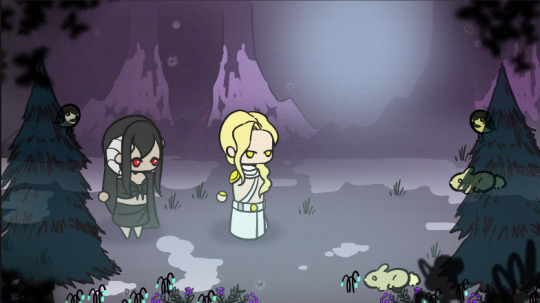
Me! I want to! 👋 Hi, I'm Amaiguri. I'm a full time gamedev and I've released two games before and correctly predicted how much money I would make each time! Wow!
I've been considering converting the webfic I write into a story game of some kind -- a visual novel or a RPGmaker game or maybe even a walking sim? But I didn't know what I wanted to make!
This story has been THE STORY of my early adult life here -- it is SO important to me. So, while I'm a huge advocate of making whatever you want, I wanted to ensure whatever I put my effort into would be VAGUELY marketable. (Because, lemme tell you, webnovels are not marketable XD)
Before I dive in too deeply, **BIG DISCLAIMER**:
I am not a business person. I am using big, wide guestimates to make non-essential business decisions with myself. BUT I want to share my learnings with you. So, take everything I say with a grain of salt and JOIN ME on this journey:
Earlier this month, I made a post about wanting to make a visual novel. Specifically, a kinetic visual novel where you don't make choices and you just read basically. SO I've now done research into how well they sold. I used THIS website to determine how much money each of these games made (VERY loosely):
Juniper's Knot: ~$4k USD
Higurashi (The Whole Series): ~$300k USD (Averaging like 400 reviews per game and $50 for the whole bundle)
House in Fata Morgana: ~$1 million USD
I picked these out mostly because these are the small handful of kinetic novels I have actually heard about. I'm not saying there aren't other, more successful ones I haven't heard about but I figure, if I'm supposed to be representative of my target audience, I'm as good of a sample as any for this wild estimation.
Besides, Higurashi has a whole anime -- it is definitely fair to use that as an upper end -- and Juniper's Knot -- a tiny game no one has heard of -- as the lower end. (I mean, $0 is the lower end, but... you know...)
This paints a pretty stark picture, honestly. Like, this is looking at 6 to 8 years of work for... maybe a couple thousand for me? Realistically? Maybe up to $300k if I'm super lucky and go viral? And I'm not saying that isn't LIFE CHANGING money but like in the MOST MIRACULOUS scenario here, I am compensated less than my current salary for my current magnum opus. But realistically, I'm looking at maybe $1-4k if I get lucky. I'm not a horror-writer and I'm not a romance writer -- I will not have THAT feral of a fanbase XD And on top of all of that, I don't even play that many kinetic visual novels. I'm barely in my own target demo here!
Now, compare that to the numbers I ran on RPGmaker games where you just do narrative and there is very minimal gameplay:
Rakuen: 4000+ Reviews, over $100k in profits estimated
To the Moon: $8 Million in profit
A Bird Story: Definitely sold worse than To the Moon, was cheaper to make and cheaper to buy -- estimated at $397k
Wadanohara and the Great Blue Sea: Dunno cuz it's free BUT its manga adaptation has 267 reviews on Amazon -- so the creator COULD have made bank on the actual game
See how much higher those are? Even when they're not as well known? And sure, the bottom is still $0 ultimately but the upper limit, with the most successful of these titles (and incidentally, the video game that convinced me to get into Game Design) is much much higher.
"BUT BELLE! Laura Shigihara did the music on a lot of those! You don't have Laura Shigihara!"
Ok BET! I'll hire her! The base industry rate for music per minute is $100/min. Let's suppose now she charge 10x that, cuz she's famous -- $1k/minute of music. I get her to compose a 3 minute song for $3k BUT she also brings over... say... 5% of her audience to check out my game.
That's admittedly, a high conversion rate so we'll just take 5% of Rakuen. Now, I'm imagining I'd charge like $25/copy of my game because it's gonna be like 300k words -- people pay $25 for a book of that length, so if I have art and programming also, I can do that. With just her 5% of Rakuen reviewers (21 reviewers of her 4.3k), that's like $7k USD. So, she'd probably just pay for herself and then some.
And to top all this off: I'm back in the target demo. I am ABSOLUTELY the kind of person who will play a solodev's RPGmaker game and forgive all jank and flaws and lack of gameplay if the story, art, and music are good.
That is, of course, making the assumption that I'll make good music and art 🥺🥺🥺
Now obviously, all this is WILD guestimates so like. You shouldn't make business decisions off this. I'm barely making "business" decisions -- I'm making hobby decisions. I have a full time job and I intend to keep it. BUT I think it's pretty clear where the potential money might be for me -- RPGmaker games.
Eris (Blinking): Thank you for reading!
#gamedev#story games#visual novel#rpg maker#rpgmaker#visual novel development#game development#game industry#indie dev#indie games#amaiguri
21 notes
·
View notes
Text
@aesthetic-writer18
Part 1: a economic overview of Ancient greece
Greece had pretty poor soil. They relied heavily on agricultural trade for food and their economy was reliant on imported goods. They grew olives and grapes, which were complimented by herbs and vegetables. Husbandry was badly developed, consisting mostly of sheep and goats while bees were kept for honey, which was the only source of sugar known to the greeks. Up to 80% of the Greek population was employed in the agricultural industry. Agricultural work followed the rhythm of the seasons: they harvested olives in autumn while trimming and keeping grapevines during the autumn seasons and the end of winter, while settings aside fallow land(land set aside so that it can recover nutrients) in the springs, harvesting cereals in summer and cutting wood, sowing seeds, and harvesting grapes into autumn, where the cycle would repeat. Greece had fairly mild but wet winters with hot and dry summers: typical of other mediterranean countries.Craftsmanship in greece was very much a big part of their domestic sphere(social circle), at least early on. Later around the 8th and 4th century BC(800 BC – 701 BC and 400 BC – 301 BC respectively), it moved to a more commercialized zone. Things like weaving and baking were done solely by women before the 5th century BC, before slaves were used after the expansion of commerce. Workshops were mostly family-operated and employed up until around 429 BC, following the death of Pericles, when a new class of wealthy owners and managers of workshops emerged.
Another aspect of greece’s economy was pottery. The greeks used the same method of pottery used since the bronze age. The potter's work consisted of selecting the clay, fashioning the vase, drying and painting and baking it, and then applying varnish. Part of production went to domestic use in things such as plates, containers, and lamps, commercial use for selling, and the rest served an artistic function. Pottery was often done by slaves and a few skilled artisans.
Greece practiced free trade, though later regulations were put in place to manage the trade of grains, flour, and bread. Maratime trade in greece was conducted by class of traders known as Emporoi. The state collected a duty(tax) on the cargo of Emporoi, which at Piraeus, the main port of Athens, was set to 1% or higher. One of the main drivers of trade in Ancient Greece was colonization. As larger city states set up colonies, there would be trade between the founding city and its colony. Furthermore, different climates in these colonies created a comparative advantage in goods. The growing amount of trade in greece led to new financial techniques being developed. Most merchants lacked sufficient cash assets to fund their expeditions, and as a result, had to borrow money to finance part or sometimes all of their expeditions. A loan for a large venture in athens was generally a large sum of cash(usually less that 2000 drachmas, the greek currency of the time), lent for the duration of the voyage, which typically lasted several weeks or months, and had a high rate of interest. This interest rate was often set at 12% but could reach up to a 100% interest rate. These terms were always laid out in writing. The lender bore all of the risks; in exchange, the trader committed all of their cargo and fleet. These were often seized upon arrival to Piraeus as a precautionary measure.
Greece's main exports were olive oil, wine, pottery, honey, and metalwork. Imports included grains, pork, fine pottery, eels, and pulses from Sicily, Arabia, Egypt, Ancient Carthage, and the Bosporan Kingdom. While peasants and artisans often sold their wares, there were also retail merchants known as kapeloi. They grouped into guilds and sold fish, olive oil, and vegetables. Women would sell perfume or ribbons, and merchants were required to pau a fee for their space in the marketplace. The general population viewed them poorly. Aristotle labled their activity "a kind of exchange which is justly censured, for it is unnatural, and a mode by which men gain from one another.” Greece also apparently didn't directly tax their people. The Eisphora was a tax on the very wealthy, usually only levied in wartime. Particularly large fortunes were subject to liturgies: the support of public works. The Diaspora was another form of tax which only applied to the wealthiest. The citizens could reject the taxation, however, if they believed someone else was wealthier and not being taxed. The wealthier would have to pay for the liturgy. On the other hand, indirect taxes were quite important. Taxes were levied on houses, slaves, herds and flocks, wines, and hay, among other things. Shopping centers in greece were known as Agoras. early in Greek history free-born citizens would gather in the agora for military duty or to hear statements of the ruling king or council. Every city had its agora where merchants could sell their products. Prices were rarely fixed, so bargaining was a common practice.
5 notes
·
View notes
Text
My year in books, 2023
2023 was a pretty good year as far as reading went. Was my lowest reading year for the past three years with the goal of finishing 40 books, and ending up finishing 45 (finished 50 last year), but that's okay. This happened to be a very good video gaming year, so reading took the backseat a bit. Watch me nerd out about my book stats below!
I like crunching some basic metrics around my reading each year, mixing some stuff from Goodreads, TheStoryGraph, and some of my own calculations. Let's start with the basics.
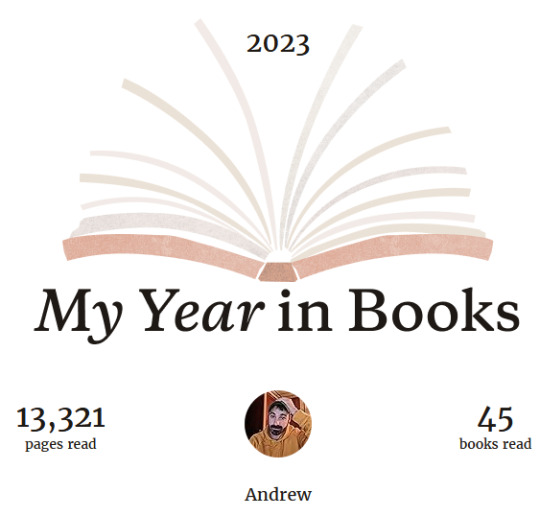
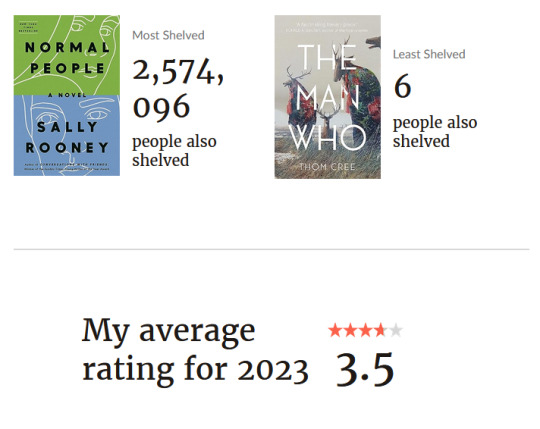
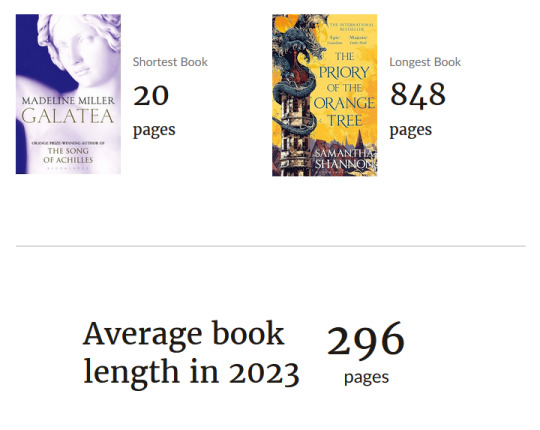
God The Priory of the Orange Tree was the first book I read last year, and it feels like forever ago. I really did try to get to the prequel this year, but it fell through the cracks!
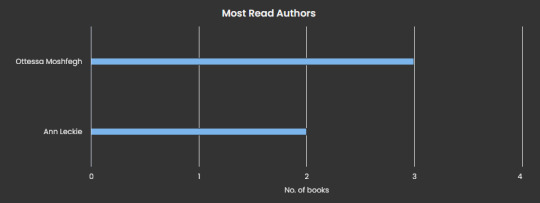
Otessa Moshfegh has quickly become one of my favorite authors. I can't wait to read her entire backlog of works. And of course I stan Ann Leckie, I'll always read whatever she puts out. Was so thankful to get to read an advance copy of a short story collection she has coming out.
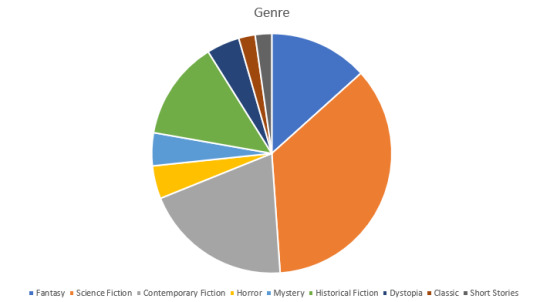
Man I read a lot of sci fi this year. Usually sci fi and fantasy are a bit more balanced, but I read some really good sci fi this year, so I was stuck on it. Notably, I didn't read any nonfiction, romance, or thrillers the whole year. I usually get a couple of those in.

My book ratings look pretty good for 2023, lots of 4 stars and few 2s and 3s. Standard disclaimer, I usually stop reading books that I really don't like, so I generally don't have many one-star reviews because I just stop reading them and I don't rate books that I don't finish.
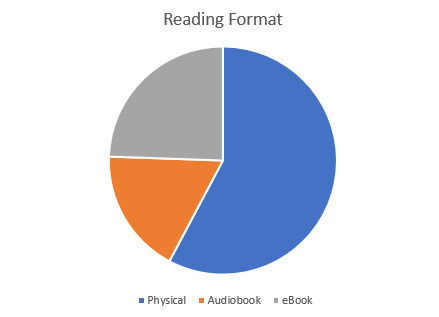
This is interesting, because in previous years, I didn't really read any ebooks ever. What changed this year was that I got on Netgalley, a site where you can read advance copies of books to provide feedback to publishers before the books release, and they generally provide an ebook for you to read. Extra surprising that I read more that way than audiobooks, which have been on a slow decline given the fact that I don't do a ton of activities that can be paired with listening to a book these days.
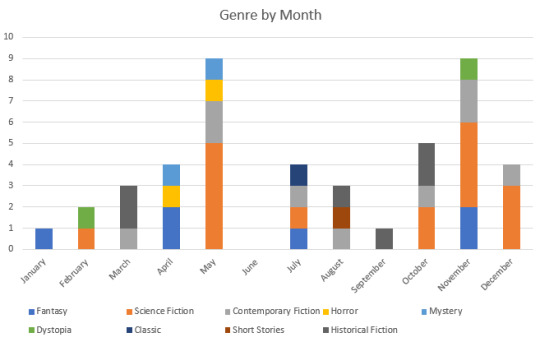
I read at least one science fiction book for six months out of the year. Actually pretty surprised to see so much Historical Fiction on here as well as I don't really like that genre.
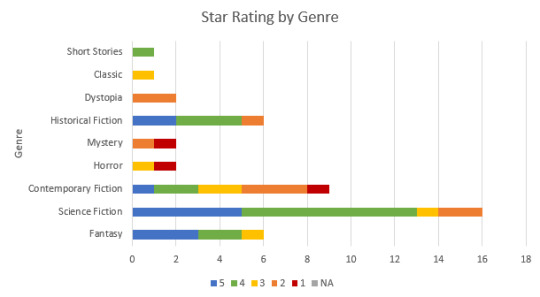
Damn, I sound like a broken record, but this makes it clear how much I really enjoyed science fiction 13 of the 16 sci fi books I read got a 4 or 5 star. Surprising to see that contemporary fiction got mainly middling ratings, that's generally my second favorite genre. I know I read a lot of fantasy, but I don't actually tend to love a lot of it lol. But this looks like a successful fantasy year as far as ratings go.

Man, 100-200 page books had it rough this year. This is interesting to me, I think the 300-400 range is my ideal, and while it had a similar number of 4/5 star ratings as the 400-500 range, it obviously had some duds in there too. But I'm surprised to see how much I seemed to enjoy the really long books, usually I start to get pretty bored at the 450 page mark.
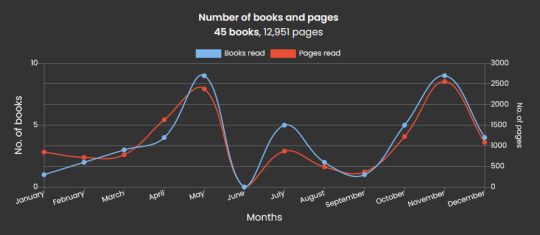
This is one of my favorite graphs because it shows the months where I rush to finish short books so I can keep up with my reading goal of the year. July seems to be particularly egregious with reading 5 books but not even reading 1000 pages total. I always start the year with the long books...
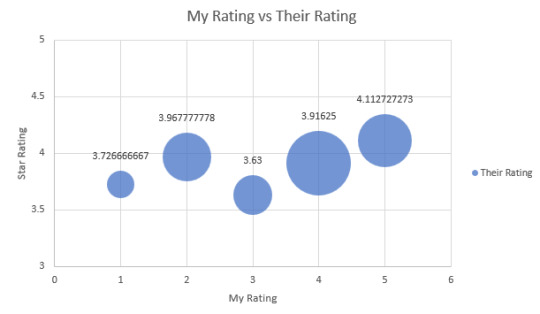
This is a new metric for me, I decided to compare my rating of books with their average rating on goodreads to see how much I generally agreed/disagreed with the average. This was honestly probably not the best year to do this as I mentioned before, I read a lot of ARCs (advanced reader copies) meaning they have few to no ratings, so my ratings of them skewed the average quite a bit, throwing this whole thing into question (I didn't record number of ratings so I couldn't put in error bars, and I'm lazy and don't know stats that much). Anyway, in this graph, the size of the bubble indicates the number of books I read at that rating during the year, so you can see the 1 star bubble is small because I didn't read a ton of books I rated 1 star. This is such an interesting pattern though, my 1 star books aren't the lowest average, but they're pretty low, but my 5 star books are definitely the best. But the 2-4 star books are a bit all over the place. I'm interested to see how this will map over time when I throw in some of the previous years in
Anyway, that's all I have. I'm going to bump up my goal back to 50 this year, hopefully I can tackle it. I'm hoping to get involved in some book clubs as well, so I hope that'll keep me honest. I don't think people actually care about these posts, but keep an eye out for some more bookish posts soon as I dive into some of the notable reads of last year. To end, here's all of the books I read in 2023

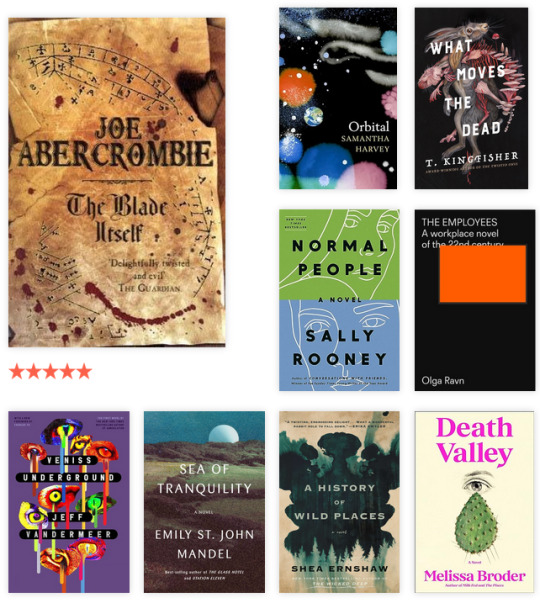

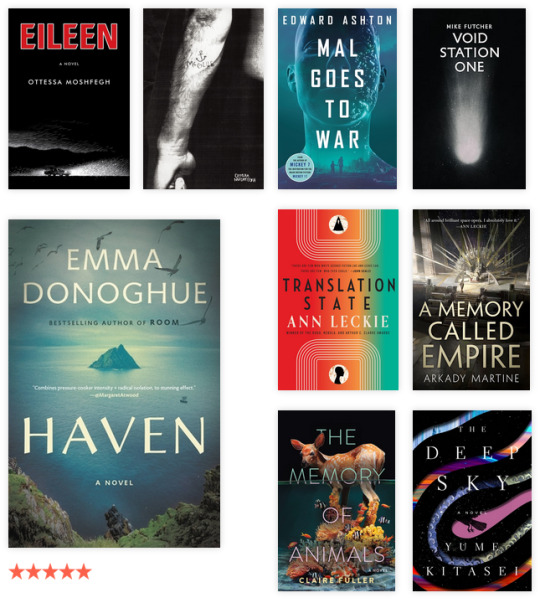
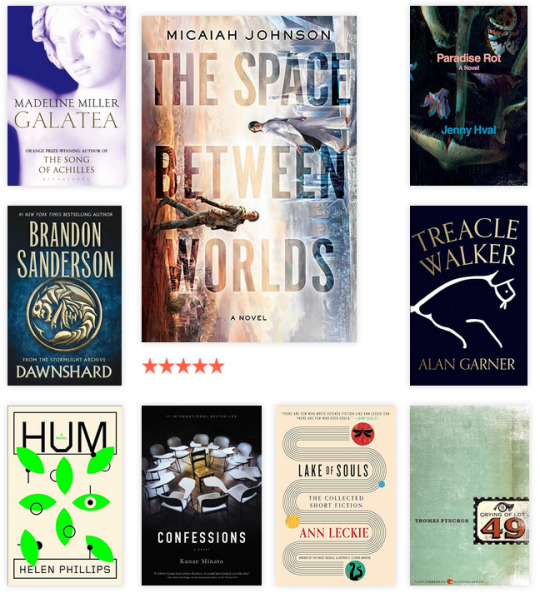
17 notes
·
View notes
Text
Decoding Time Series Analysis: Navigating Complex Numerical Challenges in Statistics Without the Fuss of Equations
Time Series Analysis stands as a robust and indispensable tool within the realm of statistics, providing us with the means to unveil intricate patterns and trends concealed within temporal data. In the course of this enlightening blog post, we shall embark on a comprehensive exploration of two demanding numerical questions at the graduate level. Our objective is to delve into the intricacies of dissecting time series data, all while steering clear of any daunting equations. So, fasten your analytical seatbelts as we journey through the rich landscape of these real-world problems, armed with the knowledge that will undoubtedly help with statistics assignment using R. Let's collectively hone our statistical acumen and confront these challenges head-on!
Question 1:
Consider a time series dataset representing the monthly sales of a product over the last three years. The sales data is as follows:
Year 1:
Month 1: 120 units
Month 2: 150 units
Month 3: 180 units
...
Month 12: 200 units
Year 2:
Month 13: 220 units
Month 14: 250 units
Month 15: 280 units
...
Month 24: 300 units
Year 3:
Month 25: 320 units
Month 26: 350 units
Month 27: 380 units
...
Month 36: 400 units
a) Calculate the moving average for a window size of 3 months for the entire time series.
b) Identify any seasonality patterns in the data and explain how they may impact sales forecasting.
c) Use a suitable decomposition method to break down the time series into its trend, seasonal, and residual components.
Answer:
a) Moving Average Calculation:
For Month 3, Moving Average = (120 + 150 + 180) / 3 = 150 units
For Month 4, Moving Average = (150 + 180 + 200) / 3 = 176.67 units
Continue this calculation for the entire time series.
b) Seasonality Patterns:
Seasonality can be observed by comparing the average sales for each month across the three years.
For example, if the average sales for January is consistently lower than other months, it indicates a seasonality pattern.
c) Decomposition:
Use a method such as additive or multiplicative decomposition to separate the time series into trend, seasonal, and residual components.
The trend component represents the overall direction of sales.
The seasonal component captures recurring patterns.
The residual component accounts for random fluctuations.
Question 2:
You are provided with a monthly time series dataset representing the stock prices of a company over the last five years. The stock prices are as follows:
Year 1: $50, $55, $60, $52, $48, ..., $58
Year 2: $60, $65, $70, $62, $58, ..., $68
Year 3: $70, $75, $80, $72, $68, ..., $78
Year 4: $80, $85, $90, $82, $78, ..., $88
Year 5: $90, $95, $100, $92, $88, ..., $98
a) Calculate the percentage change in stock prices from one year to the next.
b) Apply a suitable smoothing technique (e.g., exponential smoothing) to forecast the stock prices for the next three months.
c) Assess the stationarity of the time series and suggest any transformations needed for better forecasting.
Answer:
a) Percentage Change Calculation:
For Year 2, Percentage Change = [(Stock Price in Year 2 - Stock Price in Year 1) / Stock Price in Year 1] * 100
Repeat this calculation for the subsequent years.
b) Exponential Smoothing:
Use the exponential smoothing formula to forecast the stock prices for the next three months.
c) Stationarity Assessment:
Use statistical tests or visual inspection to assess stationarity.
If non-stationarity is detected, consider transformations such as differencing to achieve stationarity for better forecasting.
Conclusion:
As we conclude our exploration of these graduate-level time series analysis questions, we've unraveled the complexities of analyzing sales and stock price data. From moving averages to decomposition and from percentage change to exponential smoothing, these exercises showcase the versatility and power of time series analysis in extracting meaningful insights from temporal datasets. Armed with these skills, statisticians and data analysts can make informed predictions and contribute to sound decision-making in various fields. So, next time you encounter a time series conundrum, approach it with confidence and the analytical prowess gained from mastering these challenging questions.
#R Assignment Help#statistics assignment help#online assignment help#Education#university#academic success
7 notes
·
View notes
Note
How long have you had your motorcycle license for now? What's it like having a bike VS a car? I imagine it makes shopping a bit of a pain - or do bikes have more storage on them than they appear?
1. I've had my learner motorcycle license for about 7 months now. I plan on going for my restricted after I hit 1000ks and do at least one Ride Forever course and/or one-on-one lesson to make sure I'm doing things correctly.
2. Motorcycle riding is a bit like riding a pushbike but no pedalling and the clutch is your Roman Empire.
I can't speak to personally owning or using a car since I have yet to get behind the wheel. Definitely better for all-weather use and there are different costs involved.
Vehicle registration (rego) for Despechá (Honda CB125F) is just over NZ$400 a year, compared to my dad's Ford Mondeo, which is a bit over NZ$100. This is due to the much higher ACC levy (about $300pa on mine, I pay more in GST than the actual license fee component of my rego) on motorcycles due to the increased risk of injury/death riding.
Fuel-wise, bike is far more economical. A full tank from empty would cost about NZ$30 (11L tank @ ~$2.70/L for 91 unleaded) at the current fuel prices and gets me about 700ks. Would be about $100 to fill the Mondeo for a roughly equivalent range.
Full coverage insurance costs for both vehicles is about the same at about $400pa.
Parking can be a lot cheaper for motorcycles (free dedicated on-street parking). Have to go out of your way for free on-street parking for cars in the city centre. Otherwise, paying at least $4 for an hour of parking.
Gear can be pricy too. Helmet is legally required, and gloves are the bare additional minimum for many, but ideally, you'd have a jacket and boots, and maybe pants. If not to avoid road rash, then to avoid hypothermia in winter. Though it's up to the individual and how much gear they want to wear.
You do get to use high occupany and some bus lanes if you ride here which can make some commutes quicker.
3. I've become a lot more mindful of how much I can carry on the bike. There isn't much stock storage on mine. Only enough space to store her toolkit and spare manual under the seat.
I don't use my bike for a lot of grocery shopping beyond picking up bread and milk so a backpack suffices. Planning on buying panniers and a tank bag but that's becoming less for shopping and more for future travel plans.
Some scooters do have a lot more storage under the seat or on the steering column. It depends on the model.
5 notes
·
View notes
Note
Greetings and hello!
I'm replying to your post about the Holocaust. I'd imagine it's gotten some very unpleasant answers already, but I'm going to do my best not to be unpleasant. I'd much rather assume, and my impression is, that it was motivated by lack of knowledge, not malice or antisemitism.
I'm really most confused by the part of it that says Netanyahu, the Israeli Prime Minister, has “more kills” than Hitler. The Palestinian territories, have a population of roughly 5 million, 2 million in Gaza and 3 million in the West Bank if I remember right. Even with if we're thinking only of the 6 million Jews murdered during the Holocaust, Netanyahu could preside over the killing of single Palestinian and that would still be a million less than were killed during the Holocaust. And that's putting aside 2 million Poles, millions of Soviets, and 3 million Soviet PoWs, among countless more. There were single months were more people were killed over the course of operation Reinhard than have died in Gaza since October 8th. And again, Hitler starved to death greater numbers of people than there are in Gaza. There were individual killing actions which had comparable death tolls to what we've seen in the past 8 months(particularly I'm thinking of Babyi Yar, outside of Kyiv). Even before the intense period of mass killing began in 1941, the Germans went into Poland in 1939 with a list of 61,000 people they intended to kill. I'm genuinely extremely curious as to where the idea that Netanyahu had killed more people from, though I don't expect you to share and make no demand that should do so.
Hitler oversaw genocides, with varying degrees of violence, against not only Jews but Roma, Sinti, the Soviet peoples, the Poles, the Serbs, the Czechs, the Luxembourgish, and that's an incomplete list.
I want to close off by telling you a bit about Treblinka. It was an extermination camp(in German, vernichtungslager, vernichtung can be translated either as extermination or annihilation), built in occupied Poland, near Warsaw. It began construction in Spring of 1942, and began operation on July 23rd. It was roughly 600×400 meters, including the train station, the living areas for the guards, the killing area, and a large amount of open space. It has three gas chambers, 4×4 meters each, connected to the train station and processing area by a curved path of barbed wire about 100 meters long which the Germans nicknamed “the path to heaven.” In the first five weeks of operation, it killed roughly 312,500 people. In the early stages, between 5000 and 7000 people were killed there each day. Later, this number would get as high as 15,000 in a day. One survivor recounted this:
‘When we reached Treblinka and the Germans opened the freightcar doors, the scene was ghastly. The cars were full of corpses. The bodies had been partially consumed by chlorine. The stench from the cars caused those still alive to choke. The Germans ordered everyone to disembark from the cars; those who could were half-dead.
On the way to the gas chambers, on both sides of the fence, stood Germans with dogs. The Germans beat the people with whips and iron bars so they would run and push to get into the "showers" quickly. The women's screams could be heard far off in other sections of the camp. The Germans urged the running victims on with yells of "Faster, faster, the water's getting cold and more people still need to shower.”’
Another recounted the following:
“The square where we sat was guarded on all sides. By a telephone pole were two notice boards. I read the announcements on them printed in large letters: “Jews of Warsaw, Attention.” These were primactions for people arriving at a labor camp; they were told to deposit their clothes for disinfection and were promised that money and valuables would returned. man arrived and selected am young men out of our group; he didn't want older men. A while later another SS man demanded sixty men; I was among that group. They marched us two by two through the square we had traversed when we left the freight cars, then to the right, to a larger square, where we were confronted by a staggering sight: a huge number of corpses, lying one next to the other. I estimate there were 20,000 corpses there. most of whom had suffocated in the freight cars. Their mouths remained open, as if they were gasping for another breath of air. Hundreds of meters away, a scoop-shovel dug large quantities of earth from the ditches. We saw a lot of Jews busy carrying the bodies to these huge ditches. Some of them transported the bodies in handcarts to the ditches at the edge of the square. These Jews did everything at a run. The bodies were laid in the ditches, row upon row. A group of laborers were pouring chlorine on the corpses. I should mention that those buried at this square were not gas-chamber victims, but rather the bodies removed from the transports and those who had been shot at Treblinka. Often we heard pistols shooting and bullets whistling. We didn't hear the screams of those shot; the Germans fired at the nape of the neck, and the victim never even moaned.
The German who brought us to work had the impression that one of the youths in our group was working sloppily. He took his rifle from his shoulder, and before the youth knew what was happening, he was no longer alive. A few minutes later the same thing happened with another Jew, shot by a Ukrainian, who took a packet of money from the man he shot. Within a short time, only ten men remained in our group. At night another transport arrived at the camp. We ran toward the cars. I was shocked. All the cars were filled only with the dead-asphyxiated. They were lying on top of one another in layers, up to the ceiling of the freight car. The sight was so awful, it is difficult to describe. I asked where the transport had come from; it turned our from Miedzyrzec. There was nowhere to place the corpses. Near the railroad tracks were large piles of clothing, and under these were still-unburied bodies. We laid the bodies in layers, near the railway. Occasionally, moans could be heard from under the piles of clothes as people recovered consciousness and asked in a weak voice for water. There was nothing we could do to help; we were dying of thirst ourselves. Those still alive were moved to the side, nearer to the clothes. It was dark, and the Germans didn't notice. Among those living I found a baby, a year or a year and a half old, who had woken up and was crying loudly. I left him by the side. In the morning he was dead. The next day, our first job was to remove the bodies of the people from Kielce from the barrack. Later we had to remove the bodies of people who had drowned in a well.”
Later a pit was dug near the train station, so deportees who couldn't walk to the gas chambers, the injured, disabled, or nearly dead, could be shot. Ten more gas chambers were also constructed, these ones were larger. One of the laborers forced to construct the new chambers recalled:
“The work of building the new chambers lasted five weeks. To us it seemed an eternity. The work went on from sunrise to sunset, under the whips and rifle butts. One of the guards, Woronikov, beat and maltreated us mercilessly. Every day a few workers were murdered. While our physical distress was far beyond normal human concepts, it was our morale that suffered even more. Every day new transports arrived; the deportees were ordered to strip, and then they were taken to the three old gas chambers. The way to the chambers passed near the construction site. Several of us discovered their children, wives, or relatives among the victims. If anyone was moved by his anguish to run to his family, they shot him on the spot. Thus we built the death chambers for ourselves and for our brothers.”
Over the course of its operation, which went on until October 1943, the extermination camp Treblinka murdered more than 700,000 people. Estimates range from 720,000 to just under a million people.
I hope I've managed to convey to you the degree to which the comparison is incorrect, repulsively so. No modern state, even Russia, which is currently waging a genocidal imperialist war of conquest which has earned it frequent comparisons to Hitler, is comparable to the Third Reich. In just 13 years, and really only during 6 of those years, it killed well over 10 million civilians, and countless more soldiers. In a single year, 1942, the Nazi state killed 2.7 million Jews. 2,700,000. I haven't heard an estimate for the death toll estimate regarding Palestinians murdered by the Israeli government which goes above 40,000. The comparison is not just incorrect, but horrifically so.
I decided against sending this anonymously, both because that would feel incorrect given the heaviness of the subject matter being discussed, and because I want you to be able to contact me if you want to. I'm more than willing to discuss this further, especially given my incredibly low opinion of the standard history education across basically the entire world. I hope you've found something valuable here, and that you'll reach out if there's anything you'd like me to clarify, or anything you want to further discuss. Hope you're doing well!
Very nice essay, and obviously well researched. I will admit I heard this a while ago and due to my ineffable autism have forgotten where I heard it. However! One genocide does not excuse another! I feel as though we have definitely established Hitler as the lowest form of human life, but that does not mean Israel gets to kill thousands of people- let alone one person. I don't need research to tell you that carpet bombing rafah after declaring it a safe place is, in fact, a war crime. I don't care about anyone's religion, race, gender, or anything- no one is entitled to a genocide or an apartheid state. And yes, the dictionary definition of a genocide is the systematic dehumanisation and eradication of a culture or people. Which is exactly what Israel is doing.
#dont post politically usually#but baseline is israel needs to go#no more people need to be killed#hell ill fully admit i was wrong earlier#but not as wrong as a genocide
2 notes
·
View notes